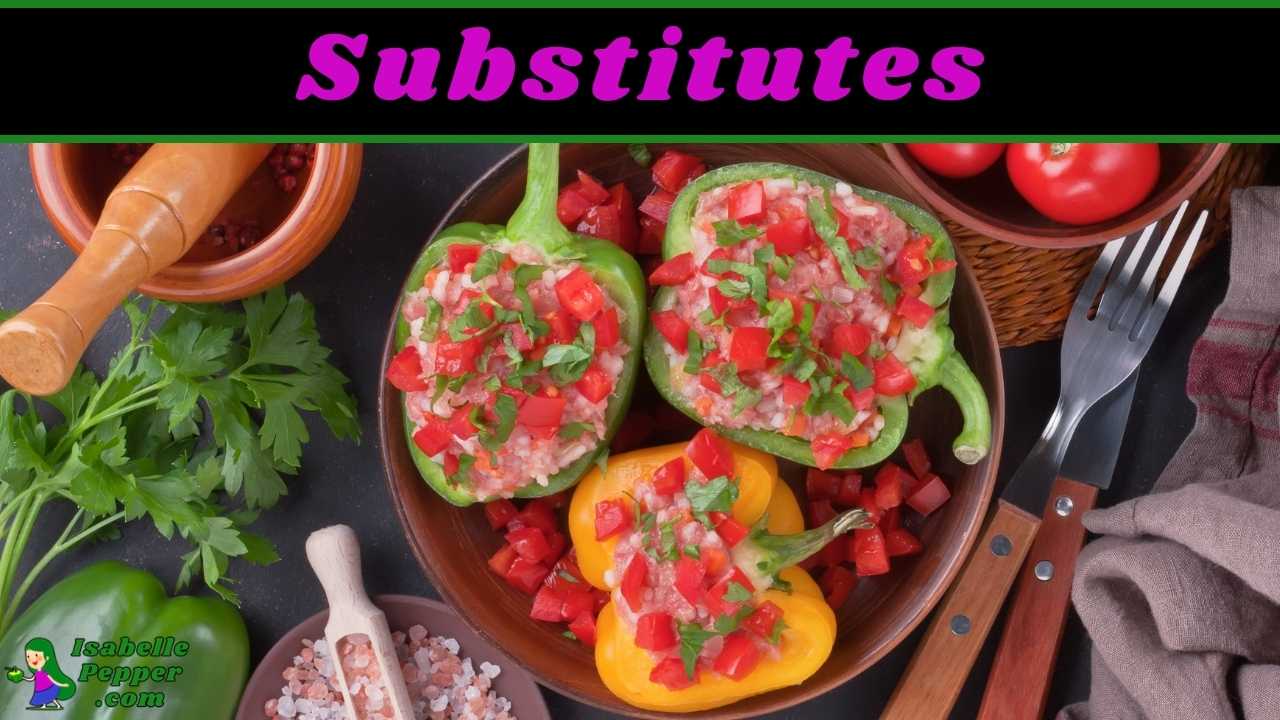Bell peppers, with their vibrant colors and crisp bite, are a beloved addition to salads, stir-fries, and a wide range of dishes.
Their distinct crunchy texture is a key factor in their popularity, but have you ever wondered what gives bell peppers that satisfying crunch?
In this article, we delve into the intriguing world of bell pepper crunchiness, exploring various factors that contribute to their texture and addressing common questions about their preparation and consumption.

What Gives Bell Peppers Their Distinct Crunchy Texture?
Bell peppers owe their distinct crunchy texture to a combination of factors, primarily rooted in their unique cellular composition and water content.
The structure of bell peppers is made up of plant cells, and it’s the arrangement of these cells that contributes to the satisfying crunchiness we associate with them.
Within each bell pepper cell, there is water held in place by the cell walls. This water content plays a crucial role in maintaining the crisp bite.
When you bite into a bell pepper, the pressure applied by your teeth ruptures the cell walls, releasing the water and creating the characteristic crunch.
Additionally, the thickness of the cell walls varies across different parts of the bell pepper. The outer layers, particularly closer to the skin, tend to have denser and thicker cell walls, enhancing the overall crunchiness.
The cellular structure of bell peppers, coupled with the water content and variation in cell wall thickness, creates the satisfying and refreshing crunch that makes bell peppers a delightful addition to countless dishes.
How Does the Freshness of a Bell Pepper Influence Its Crunchiness?
The freshness of a bell pepper directly impacts its crunchiness.
A fresher bell pepper will generally be crisper and more satisfying to bite into compared to one that has lost its freshness.
As bell peppers age, they undergo changes in their cellular structure.
The water content within the cells can decrease over time, causing the pepper to lose some of its natural crispness.
The cell walls may also break down or become less rigid as the pepper ages, leading to a softer texture.
When selecting bell peppers for maximum crunchiness, opt for those that feel firm and have taut skin.
Avoid peppers with wrinkles, soft spots, or signs of shriveling, as these are indications of decreased water content and potentially diminished crunchiness.
Why Are Green Bell Peppers Crunchier Than Red or Yellow Bell Peppers?
Green bell peppers are often crisper than their red or yellow counterparts due to their stage of ripeness.
As peppers mature and change color, their cellular structure undergoes alterations that can affect their crunchiness.
Green bell peppers, being less ripe, maintain a firmer texture.
Are There Certain Parts of a Bell Pepper That Are Crunchier Than Others?
Yes, different parts of a bell pepper can vary in crunchiness.
The fleshier and thicker walls of the pepper, especially those closer to the outer skin, tend to be crunchier.
The central core and the seeds may be softer in comparison.
If you’re wondering if the skin of a bell pepper is actually healthy to eat, check out my recent article on that topic by clicking here
Are There Specific Bell Pepper Varieties Known for Their Exceptional Crunch?
While bell pepper varieties generally share a similar level of crunchiness, some individuals may perceive variations based on personal taste preferences.
However, no specific bell pepper varieties are universally recognized for having an exceptional crunch.
The perception of crunchiness can be influenced by factors such as freshness, ripeness, and cooking methods rather than inherent differences between varieties.
How Does Cooking Impact the Crispness of Bell Peppers?
Cooking can significantly impact the crispness of bell peppers.
Heat breaks down the cell walls in bell peppers, causing them to soften and lose some of their natural crunchiness.
The extent of this change depends on the cooking method and duration.
Quick cooking methods like stir-frying or sautéing may preserve more crunch compared to prolonged cooking methods such as roasting or stewing.
To maintain crunchiness, some chefs opt for shorter cooking times or add bell peppers towards the end of the cooking process.
Additionally, blanching bell peppers before cooking can help retain their crisp texture.
What Happens to the Cellular Structure of Bell Peppers When They’re Cooked?
When bell peppers are exposed to heat during cooking, the heat causes the water within their cells to expand and evaporate. This process can lead to the softening of the cellular structure, resulting in a change in texture.
Are There Ways to Prevent Bell Peppers From Becoming Soggy in Cooked Dishes?
To prevent bell peppers from becoming soggy in cooked dishes, it’s essential to avoid overcooking them. Cooking them briefly and using techniques that minimize moisture loss can help maintain their crunch.
What Role Does Seasoning Play in Enhancing or Altering the Crunchiness of Bell Peppers?
While seasoning itself doesn’t directly affect the texture, the way you season and marinate the peppers before cooking can impact their final crispness.
Salt, for example, can draw out moisture from the peppers, potentially leading to a slightly softer texture.
On the other hand, using dry seasonings or marinades with high acidity can help maintain crunchiness by preventing excessive moisture absorption during cooking.
Herbs, spices, and oil-based marinades can also add layers of flavor without significantly altering the crunch.
The choice of seasoning and the timing of its application can influence whether the peppers remain crisp or become softer during cooking.
How Does Blanching Impact the Crunchiness of Bell Peppers Before Cooking?
Blanching, a brief boiling followed by immediate cooling in ice water, can help preserve the crunchiness of bell peppers before using them in cooking.
This technique helps to partially cook the peppers while retaining their crispness.
How Does the Thickness of Bell Pepper Slices Affect Their Final Texture?
Thicker slices tend to retain more of their natural crunchiness, as the increased thickness provides a protective barrier against the breakdown of cell walls during cooking.
Thicker slices take longer to cook through, allowing the heat to penetrate gradually and preserving the crispness.
On the other hand, thinner slices have a larger surface area exposed to heat, which can lead to faster moisture loss and softer texture.
Do Bell Peppers Lose Their Crunchiness When Frozen and Thawed?
Yes, bell peppers tend to lose some of their crunchiness when they are frozen and thawed.
The process of freezing and thawing can cause the cell walls in the bell peppers to break down, leading to a softer texture.
How Do Pickled Bell Peppers Retain Their Crunchiness?
When bell peppers are pickled, they are submerged in a solution of vinegar, water, and spices.
The acidity of the vinegar helps to preserve the firmness of the peppers by slowing down the enzymatic processes that lead to softening.
The pickling solution also helps maintain the structural integrity of the cell walls in the peppers, contributing to their crunchy texture even after the pickling process.
As a result, pickled bell peppers can offer a satisfying crunch when consumed.
FAQs
Are There Differences in Crunchiness Between Homegrown and Store-Bought Bell Peppers?
Homegrown bell peppers often have the advantage of being harvested at their peak ripeness, which can contribute to better texture and crunchiness.
Store-bought bell peppers may have been harvested earlier to withstand transportation and have a longer shelf life, potentially affecting their crispness.
Additionally, factors like freshness, handling, and storage conditions can impact the overall crunchiness of bell peppers, regardless of whether they are homegrown or store-bought.
Can You Achieve a Balance Between Crunchiness and Tenderness in Bell Peppers?
Yes, it is possible to achieve a balance between crunchiness and tenderness in bell peppers. The key lies in choosing the right cooking method and duration.
Quick cooking techniques like stir-frying or grilling can help maintain a desirable level of crunchiness while also allowing the bell peppers to become tender.
Additionally, controlling the cooking time and using high heat can help strike a balance between these two textures.
Monitoring the cooking process closely and adjusting techniques accordingly can help you achieve the perfect combination of crunchiness and tenderness in your bell peppers.
How Does the Crunchiness of Bell Peppers Compare to Other Vegetables?
When compared to other vegetables, the crunchiness of bell peppers can vary based on their moisture content, cellular structure, and thickness.
While bell peppers do offer a satisfying crunch, they might not be as intensely crisp as vegetables like celery or carrots.
Vegetables with high water content tend to have a crispier texture. Celery, for example, is primarily composed of water, making it exceptionally crunchy when bitten into.
Carrots also have a dense cellular structure that contributes to their notable crunch.
Bell peppers, while still providing a pleasant crunch, have a slightly different texture due to their cellular composition.
Does the Level of Ripeness Affect the Crunchiness of a Bell Pepper?
Yes, the level of ripeness does affect the crunchiness of a bell pepper.
Generally, less ripe bell peppers are firmer and have a more pronounced crunch. As bell peppers ripen, they tend to become softer and slightly less crunchy.
The color change from green to red, yellow, or orange is an indicator of increased ripeness and a corresponding change in texture.
How Does the Crunchiness of Raw Bell Peppers Contribute to Their Overall Appeal?
The crunchiness of raw bell peppers provides a satisfying sensory experience when biting into them, adding an element of freshness and liveliness to dishes.
The crisp bite of a raw bell pepper contrasts with its vibrant colors and mild sweetness, creating a dynamic flavor and texture combination.
The crunchiness also adds a textural dimension to various recipes.
Whether used as a crisp topping in salads, a crunchy component in sandwiches, or a refreshing snack on its own, raw bell peppers enhance the overall mouthfeel of a dish.
Their crunchiness complements softer ingredients, creating a well-balanced and enjoyable culinary experience.
Furthermore, the crunchiness of raw bell peppers contributes to the perception of their freshness and quality.
A firm and crisp texture is often associated with a ripe and well-preserved vegetable, indicating its readiness for consumption.
This quality makes raw bell peppers an appealing choice for both visual presentation and taste.
Conclusion
The crunchiness of bell peppers is a fascinating interplay of factors, from cellular structure to cooking techniques.
Whether you enjoy them raw in a salad or cooked in a stir-fry, understanding how to achieve and maintain their crunchiness can elevate your culinary creations.
By carefully considering these factors, you can savor the delightful bite that bell peppers bring to your meals.





